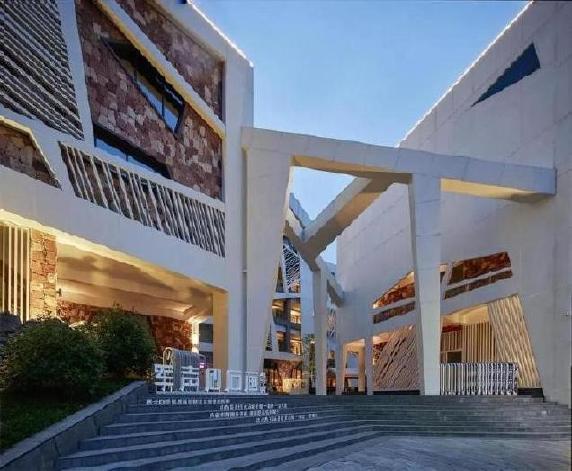This is a group of peaceful courtyards located in the Taoxi River Industrial Heritage Protection and Renewal Area of Jingdezhen.

The overall architectural layout starts from maximizing the preservation of an old tree on the site, and focuses on preserving, repairing, and locally adding to the existing warehouses, dormitories, and distribution rooms, with an area of 8290 square meters.

The design team chose “yard” and “porch” as the main space types.

The camphor tree forest with its canopy touching each other is enveloped by a new double layered wooden corridor.

The bottom floor of the corridor is elevated, and the second floor is completely transparent, creating a quiet atmosphere of the academy, serving as the “spiritual leader” of the entire place.

Around the old wutong tree in the west, a brick courtyard opened inwards, carrying various conference functions.

The ceramic bricks around the old wutong are warm brown, close to the soil, thinner than ordinary bricks, and the size of the bricks is consistent with that of the local kilns in Jingdezhen.

The architect concentrated the guest rooms, with a three story high volume built above the old house in the north, a single corridor facing the outside street for lighting, and a balcony opening towards the camphor forest in the south, overlooking the vast urban landscape and continuous mountain ranges.

The mountain wall of the old warehouse in the south and the paulownia trees attached to it are like an isolated island that has been fully preserved and reinforced, while the rest have been completely removed and overhauled.
To meet its new functions, its roof has been raised by 1 meter, and the gaps between the double eaves generated by the new and old heights have skylight and tree shadows.
The roof truss has been replaced with a steel truss to continue the form of the original wooden truss.
The eastern and western sections of the space have been transformed into a lobby and dining space, which can be opened to the public simultaneously.
Buildings sensitively convey different information and attitudes towards different urban segments around them.
On the east side, the building presents a crawling posture – the forest looks like a transparent screen in winter, a rich and soft wall in summer, and below can be seen a folding corridor eaves topped by black steel columns and several horizontally elongated courtyard walls.
This low entrance corridor descends and descends along a gentle slope with a height difference of 2 meters, crossing through dense forests and extending into the porch outside the lobby.
Old tree trunks and new steel columns together form a new spatial order in architectural design. Answer: Good design will definitely make a qualitative leap in quality of life, and good design will definitely make business more prosperous!.
Whether it’s in daily life, home, or production and operation scenarios, “function” always stands at the forefront of everything! A successful design can definitely make users feel happy and achieve twice the result with half the effort. For example, entering this bedroom can help them sleep well, and customers who come to this retail store will not leave empty handed! It is not difficult to achieve these goals. Designers only need to use ergonomics to control the scale during the production design process, and at the same time, apply materials and colors to create an atmosphere that is in line with the attributes of the use space! Of course, if it were a production and business premises, there would be a slight additional step, which is to create a work/consumption “show” for producers/consumers that lasts for several hours, is rich in content, and has a rich experience!.
Observing and reviewing the dominant architectural design ideas of the past thirty years, using the standard of “reasonable functionality” can already classify a considerable portion of architectural designs as failing (such as huge hollow living rooms, tiny kitchens, and cramped bathrooms…); There is also a considerable number of architectural design projects led by designers and inexplicably participated by homeowners, focusing on pursuing “pseudo high-end” through freehand brushwork and abstract decoration, which is actually a complete waste of both money and resources!.
Answer: It all depends on whether the funds, materials, and manpower required to repair and reinforce a new house exceed those required for new construction. It’s more than just a simple business account! However, the factors that affect the value of a building usually include land location, feng shui, and other objective factors. If these factors are encountered, it is not difficult to make two extra entries in the account. Unstoppable and highly attractive high-end residential fa ç ade [architectural design] As a high-end residential product, flat rise luxury homes have the characteristics of privacy, comfort, and high-quality property services, making them suitable for the following groups: residents who value privacy and space; Homebuyers with strong economic strength; A group of people who pursue a high-quality lifestyle. The design inspiration for the Red Fan Shell comes from the smooth curves, natural shapes of desert sand ripples and sand dunes, as well as the structure of the shell itself. Choose the shape of a shell to symbolize ancient fishing art, as Qatar was one of the earliest fishing countries in the past, and fishing was its lifeline..
The design of this modern hotel can be regarded as a luxurious and comfortable oasis, perfectly integrating modern design with the surrounding primitive scenery. The hotel boasts smooth lines and a minimalist architectural style, becoming an exquisite lighthouse against the backdrop of endless sand dunes and flowing sand. Its spacious glass curtain wall offers a panoramic view of the desert landscape, immersing guests in the tranquil beauty of the wilderness while enjoying all the comfort of modern life. The interior design exudes a warm and elegant atmosphere, with earth tones and natural materials creating a sense of harmony with the desert. Every aspect of the hotel is designed to provide you with an unforgettable desert relaxation and exploration journey..
The architectural design of Tianzhu International Hotel in Guoluo Tibetan Autonomous Prefecture, Qinghai Province draws inspiration from ethnic culture, aiming to showcase the rich connotations and unique charm of Tibetan culture. The design inspiration comes from the essence of Tibetan architectural culture, integrating traditional elements with modern architectural concepts to create a unique and distinctive hotel. The exterior of the building will incorporate artistic Tibetan decorative elements, unique window lattice design, exquisite murals, etc., highlighting the unique aesthetic of Tibetan culture..
In terms of spatial layout, the design will consider the lifestyle concept and era characteristics of Tibetan culture, creating comfortable and culturally rich functional spaces such as guest rooms, restaurants, and leisure areas. In addition, elements of the local natural environment will be integrated to coordinate the building with the surrounding landscape and provide a pleasant living experience. Through the architectural design of Tianzhu International Hotel, we aim to showcase the vibrant cultural heritage of Guoluo Tibetan Autonomous Prefecture, creating a unique architectural masterpiece that seamlessly combines tradition and modernity, culture and art.



